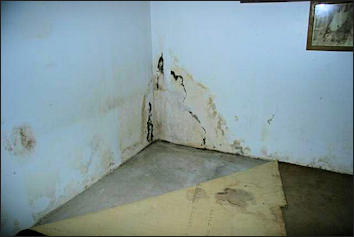Consequence Of Drywall Damaged By Water
Water damage to drywall is common. It is the result of a basement moisture problem. Wet basement drywall is a common occurrence in homes throughout the country. Left untreated, wet drywall leads to damage to your walls, the growth of mold, and mildew. This situation must be corrected.
In the image below, water from a plumbing leak damaged the floor. Seepage to the drywall occured leading to mold growth. This problem was serious and needed correction quickly!

How To Identify Wet Basement Drywall
Areas of discoloration, bulging, sagging, sloping, and wall cracks are evidence of damaged and wet drywall. Interior plumbing pipes contribute to the problem as condensation can drip along the pipes, damaging the ceiling or the walls.
You believe you know the source of the moisture problem. But damaged drywall and mold growth can exist in areas away from the moisture source. It isn't always easy to tell when drywall is wet beneath the surface. Using a moisture meter will allow you to know when the drywall has been compromised.
One good thing is that if you can see dampness in your drywall, the walls were probably painted with a couple of coats of flat or semi-gloss paint. Those finishes breathe a little, so the drying job will be easier.
Again, wet drywall is a breeding ground for unhealthy mold growth. Address the moisture problem quickly! Mold growth from moisture is dangerous black mold that causes respiratory problems. Flu-like symptoms may also occur for your family. If you are experiencing this, you need our professional help.
SKV Construction will identify the source of your moisture problem. We will make recommendations on fixing the wet drywall and removing the mold. In addition, if foundation cracks or concrete floor cracks are contributing to the moisture problem, SKV Construction will provide concrete crack repair solutions consistennt with the severity of the problem.
If you have wet or ruined drywall in your basement, Contact Us for a no obligation proposal.
